Marokko |
|
|
|
| Übersicht – Contents: | |
Marokko |
|
|
|
| Übersicht – Contents: | |
Flaggen – Flags: |
|
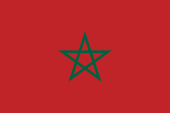 |
Nationalflagge – national flag,
Seitenverhältnis – ratio = 2:3, Quelle/Source, nach/by: Flags of the World   |
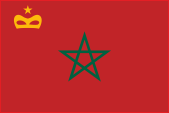 |
Handelsflagge – merchant flag, Seitenverhältnis – ratio = 2:3, Quelle/Source, nach/by: Flags of the World |
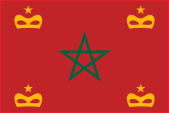 |
Marineflagge – naval flag, Seitenverhältnis – ratio = 2:3, Quelle/Source, nach/by: Flags of the World |
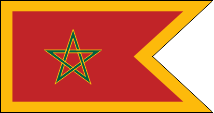 |
Gösch – jack, Seitenverhältnis – ratio = 2:3, Quelle/Source, nach/by: Flags of the World |
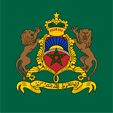 |
Standarte des Sultans – Standard of the Sultan, Quelle/Source, nach/by: Flags of the World |
|
|
|
historische Flaggen – historical Flags: |
|
 |
16. Jhd./cent. – 1915, |
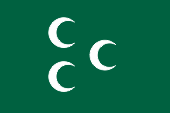 |
1810 – ca. 1850, |
|
|
|
| Französisch-Marokko – French Morocco: | |
 |
1915–1956, |
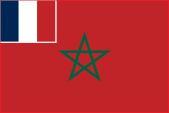 |
1923–1956, |
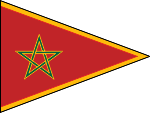 |
Standarte des Sultans – Standard of the Sultan, |
|
|
|
| Spanisch-Marokko – Spanish Morocco: | |
 |
1915–1956, |
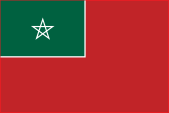 |
1937–1956, |
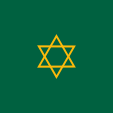 |
Standarte des Kalifen – standard of the Calif, Quelle/Source, nach/by: Flags of the World |
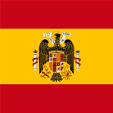 |
1945–1956, Flagge des spanischen Oberkommissars – flag of the Spanish High Commissioner, Quelle/Source nach/by: Die Welt im bunten Flaggenbild |
|
|
|
Bedeutung/Ursprung der Flagge – Meaning/Origin of the Flag: |
|
| Die heutige Flagge Marokkos wurde am 17.11.1915, durch Hinzufügung des grünen Pentagramms in der Mitte der roten Landesflagge, zunächst nur als Flagge für die Streitkräfte des Sultans, offiziell eingeführt. Dies soll auf Veranlassung des französischen Marschalls Lyautey geschehen sein, um die marokkanischen Truppen besser als Verbündete identifizieren zu können. Andere Quellen nennen jedoch Sultan Mulai Jussuf als Initiator für die Ergänzung des Pentagramms. Über den Ursprung oder die Bedeutung des Pentagramms selbst ist nichts bekannt, außer dass es sich um eine fünfzackige Variante des Siegels Salomons handelt. Als Marokko 1956 unabhängig wurde, hat man diese Flagge als Nationalflagge beibehalten. | The
today's flag of Morocco was officially introduced on 17th of November in
1915 – initially only as flag for the army of the Sultan – by addition of
the green pentagram in the middle of the red flag od the country. This should have been done by inducement of the French Marshal Lyautey to identify better the Moroccan troops as allies. But other sources mention Sultan Mulai Jussuf as initiator for the addition of the pentagram. About the origin or the meaning of the pentagram itself is nothing known except that it is a five-pointed variant of the Seal of Salomon. As Morocco became independent in 1956 this flag was maintained as national flag. |
| In der
Kolonialzeit, zwischen 1923 und 1956, verwendete Französisch-Marokko die
rote Flagge mit dem Pentagramm ergänzt um die französische Trikolore in der
Oberecke als Handelsflagge. Die Handelsflagge von Spanisch-Marokko wurde erst 1937 eingeführt. Sie war ebenfalls einfarbig rot, hatte jedoch eine grüne Oberecke mit dem Siegel Salomons in weiß. Die Farben der Flagge scheinen heute folgendermaßen definiert zu sein, und zwar: "Hellrot", was Pantone 1795 entsprechen würde und "Palmengrün", was Pantone 3425 entsprechen würde. |
In the
colonial time – between 1923 and 1956 – French-Morocco used the red flag
with the pentagram completed by the French Tricolor in the upper staff
quadrant as merchant flag. The merchant flag of Spanish-Morocco was introduced not until 1937. It was likewise single-coloured red, but had a green upper staff quadrant with the Seal of Salomo in white. The colours of the flag seem to be defined today as follows: "Bright Red", which would correspond to Pantone 7620 and "Palm Green", which would correspond to Pantone 3425. |
| Die Flagge Marokkos ist schon seit über 300 Jahren ein einfarbiges rotes Tuch. Die Farbe Rot soll den Anspruch der königlichen Familie auf ihre Abstammung vom Propheten symbolisieren. Die Alawiten-Dynastie beansprucht, über Fatima und Ali direkt vom Propheten Mohammed abzustammen. Der Herrscher trägt den Ehrentitel Emir EI-Muminin "Befehlshaber der Gläubigen". | The flag of Morocco is already since more than 300 years a single-coloured red bunting. The colour red should symbolize the demand of the royal family for their descent from of prophet. The Alawite's Dynasty claims to descent over Fatima and Ali directly from the Prophet Mohammed. The sovereign carrys the honor-title Emir EI-Muminin "Leader of the Believers". |
| Rot ist auch im Bereich des Indischen Ozeans eine Flaggenfarbe mit großer Tradition und großer Verbreitung, von den Küsten Arabiens, über Sansibar bis zu den Maldiven, die in engem Zusammenhang zum Islam steht. Rote Flaggen haben bzw. hatten alle islamischen Dynastien, die sich auf die Herkunft von den Alawiten (auch Aliden genannt, Abkömmlinge Ali's) berufen (z.B. heute noch Marokko, ehemals Nordjemen), oder auch die arabischen Emirate, einschließlich Omans. Oman hatte früher, bis etwa 1730 auch die gesamte afrikanische Ostküste unterworfen (bis weit ins heutige Mosambik hinein), und durch Verlegung des Regierungssitzes nach Sansibar (ca. 1830) ein neues Reich (Sansibar) begründet, welches auch dessen rote Flagge führte. | Red is
even in the region of the Indian Ocean a flag color with a great tradition
and wide dissemination, from the coasts of Arabia, over Zansibar to the
Maldives, which stands in dense context to the islam. Red flags had and have all islamic dynasties, which come from the Alawites (Alides, descentants of Ali) like today Morokko or former North Yemen, the Arabian Emirates and Oman. Oman incorporated till 1730 the african eastern coast, to an in the today Mocambique. They moved their capital to Zansibar (1830) and founded a new empire which had its red flag, too. |
| Quelle/Source: Flags of the World, Die Welt der Flaggen, Wikipedia (EN) | |
Wappen – Coat of Arms: |
|
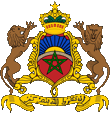 |
Wappen von Marokko – coat of arms of Morocco, Quelle/Source: Corel Draw 4, Jürgen Kaltschmitt |
|
|
|
Bedeutung/Ursprung des Wappens – Meaning/Origin of the Coat of Arms: |
|
| Das derzeitige Staatswappen (eigentlich Königswappen) wurde am 14.08.1957 eingeführt. Es wurde von den Graphikern Gauthier und Hainaut entworfen und zeigt ein grünes Pentagramm auf Rot vor dem Atlasgebirge und einer aufgehenden Sonne. Oberhalb die Könisgkrone. Zwei Löwen fungieren als Schildhalter. Auf dem Band darunter die arabische Inschrift: "Wenn ihr Gott beisteht, wird auch er euch beistehen" (Koran, Vers 7, Sure 47). | The
present coat of arms of the state (actually coat of arms of the King) was
introduced on 14th of August in 1957. It was created by the graphic artists
Gauthier and Hainaut and shows a green pentagram on red infront of the Atlas
Mountains and a rising sun. Above the royal crown. Two lions function as shield supporters. On a banner beneath the Arabic inscription: "If you help God, he will as well help you" (Koran, verse 7, sura 47). |
| Quelle/Source: Flaggen Wappen Hymnen, Flaggen und Wappen der Welt | |
Flugzeugkokarde – aircraft roundel: |
|
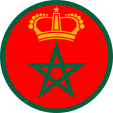 |
Flugzeugkokarde – aircraft roundel Quelle/Source: nach/by Wikipedia (EN) |
 |
Flugzeugkokarde für Marineflieger – aircraft roundel for naval aviation Quelle/Source: nach/by Wikipedia (EN) |
|
|
|
Landkarten – Maps: |
Lage – Position: |
Landkarte des Landes – Map of the Country: |
Zahlen und Fakten – Numbers and Facts: |
|
|
|
|
|
|
|
|
|
|
|
|
|
|
|
|
|
|
|
|
|
|
Geschichte: |
| 42 n.
Chr. · das auf dem Gebiet des heutigen Marokko gelegene Königreich
Mauretania wird als Mauretania Tingitana (Tingis = Tanger) Provinz des
Römischen Reiches 395 · bei der Teilung des Römischen Reiches kommt Mauretania an das Weströmische Reich 429 · Einfall der Vandalen von Spanien aus, diese ziehen aber Richtung Tunesien weiter, Mauretania bleibt in lockerer Abhängigkeit vom Reich der Vandalen 533–534 · das Reich der Vandalen wird vom Oströmischen Reich (Byzanz) erobert, Mauretania wird von Byzanz abhängig 647–700 · Unterwerfung durch das Arabische Kalifat, Islamisierung 986–1062 · Herrschaften der arabischen Dynastien der Idrisiden und Fatimiden 1062–1269 · Herrschaften der arabischen Dynastien der Almoraviden und Almohaden (einschl. Spaniens) 1269–1546 · Herrschaft der arabischen Dynastie der Scherifen von Tafilâlt (Abstammung von Ali, Schwiegersohn Mohammeds) 1415 · Eroberung von Ceuta durch die Portugiesen 1471 · Eroberung von Tanger durch die Portugiesen 1497 · Eroberung von Melilla durch die Spanier 1664 · Gründung der heutigen Dynastie der Alawiten-Sultane 1844 · militärische Auseinandersetzungen mit Frankreich 1859–1860 · spanisch-marokkanischer Krieg, Spanien besetzt Tetouan 1904 · Frankreich beginnt mit der kolonialen Erschließung 1905 · Erste Marokko-Krise, das Deutsche Reich macht Ansprüche in Marokko geltend 1911 · Zweite Marokko-Krise, das Deutsche Reich macht erneut Ansprüche in Marokko geltend und entsendet das Kanonenboot "Panther" → Panthersprung 1912 · Frankreich und Spanien errichten ihre Protektorate in Marokko (Spanien: a.) Oueddra-Streifen im Süden Marokkos, b.) Span. Nordmarokko – Frankreich: ganz Zentral-Marokko), das Deutsche Reich erkennt im Austausch gegen Gebiete in Kamerun das französische Protektorat an 1921–1926 · Aufstand der Rifkabylen unter Abd el-Krim in Spanisch Marokko, Proklamation der Rif-Republik 1923 · Tanger wird internationale Zone 1942 · im Zweiten Weltkrieg landen alliierte Truppen in Marokko 1944 · Gründung der Istiklal-Unabhängigkeitspartei 1953 · der Sultan wird von Frankreich des Landes verwiesen 1955 · der Sultan darf nach Marokko zurückkehren 02.03.1956 · Unabhängigkeit, dabei Anschluss von ehemals Spanisch Marokko (jedoch nur Rif-Gebiet), Tanger wird an Marokko zurückgegeben 1957 · der Sultan ernennt sich zum König Mohammed V. 1958 · Spanien gibt den Oueddra-Streifen an Marokko zurück 1961 · der Sohn von Mohammed V. wird als Hassan II. König von Marokko 1962 · Marokko wird Konstitutionelle Monarchie 1963 · militärische Auseinandersetzungen mit Algerien 1969 · Spanien gibt die Enklave Ifni an Marokko zurück 1970 · erste Parlamentswahlen 1971 · Putschversuch des Militärs 1975 · Spanien verzichtet auf seine Rechte in Westsahara, das Selbstbestimmungsrecht von Westsahara wird international anerkannt, Marokko und Mauretanien marschieren in Westsahara ein 1976 · Marokko und Mauretanien teilen Westsahara untereinander auf 1979 · Mauretanien gibt seinen Teil der Westsahara zugunsten der Westsahara-Befreiungsfront "POLISARIO" auf, Marokko annektiert auch dieses Gebiet 1984 · Oujda-Vertrag zwischen Marokko und Libyen zur Bildung einer Maghreb-Union 1986 · Marokko kündigt den Oujda-Vertrag 1999 · Tod von Hassan II. sein Sohn wird als Mohammad VI. König |
History: |
| 42 A.D. ·
the on the territory of the today's Morocco situated Kingdom of Mauretania
becomes as Mauretania Tingitana (Tingis = Tanger) province of the
Roman
Empire 395 · at the partition of the Roman Empire Mauretania comes to the West Roman Empire 429 · invasion of the Vandals from Spain, but those move on in direction of Tunisia, Mauretania remains in looser dependence from the Empire of the Vandals 533–534 · the Empire of the Vandals becomes conquered by the East Roman Empire (Byzantium), Mauretania becomes dependent from Byzantium 647–700 · subjection by the Arabic Califate, Islamization 986–1062 · reign of the Arabic dynasties of the Idrisides and the Fatimides 1062–1269 · reign of the Arabic dynasties of the Almoravides and Almohades (incl. Spain) 1269–1546 · reign of the Arabic dynasty of the Sherifes of Tafilâlt (descent from Ali, son-in-law of Mohammed) 1415 · conquest of Ceuta by the Portugese 1471 · conquest of Tanger by the Portugese 1497 · conquest of Melilla by the Spanish 1664 · establishment of the today's dynasty of the Alawite Sultans 1844 · military quarrels with France 1859–1860 · Spanish-Moroccan War, Spain occupys Tetouan 1904 · France starts the colonial development 1905 · First Morocco Crisis, the German Empire demands claims in Morocco 1911 · Second Morocco Crisis, the German Empire demands claims in Morocco again and sends the gunboat "Panther" → Panther Jump 1912 · France and Spain establish their protectorates in Morocco (Spain: a.) Oueddra Stripe in the south of Morocco, b.) Span. North Morocco – France: whole central Morocco), the German Empire recognizes the French protectorate in interchange with territories in Cameroon 1921–1926 · revolt of the Rif Kabyls under Abd el-Krim in Spanish Morocco, proklamation of the Republic of the Rif 1923 · Tanger becomes an international zone 1942 · in the Second World War debark allied troops in Morocco 1944 · foundation of the Istiklal Independence Party 1953 · the Sultan gets banished out of the country by France 1955 · the Sultan is allowed to return to Morocco 2nd of March 1956 · independence, with it annexion of formerly Spanish Morocco (but only Rif Area), Tanger becomes given back to Morocco 1957 · the Sultan nominates hisself to King Mohammed V. 1958 · Spain gives back the Oueddra Region to Marokko 1961 · the son of Mohammed V. becomes King of Morocco as Hassan II. 1962 · Morocco becomes constitutional monarchy 1963 · military quarrels with Algeria 1969 · Spain gives back to Morocco the enclave Ifni 1970 · first elections to parliament 1971 · attempted coup d'état of armed forces 1975 · Spain disclaims for its rights in West Sahara, the right of sovereignity of West Sahara becomes internationally recognized, Morocco and Mauritania invade West Sahara 1976 · Morocco and Mauritania partition West Sahara among themselves 1979 · Mauritania gives up its part of West Sahara for the West Sahara Liberation Front "POLISARIO", Morocco annexes this area too 1984 · Treaty of Oujda between Morocco and Libya to establish a Maghreb Union 1986 · Morocco terminates the Treaty of Oujda 1999 · death of Hassan II., his son becomes King as Mohammad VI. |
|
Quelle/Source: Atlas zur Geschichte, Wikipedia (DE), Discovery '97, Weltgeschichte, Länder der Erde |
Ursprung des Landesnamens – Origin of the Country's Name: |
|
| Der
(europäische) Name "Marokko" leitet sich von der Stadt Marrakesch her ab,
welche in der Blütezeit des Reiches im Mittelalter Hauptstadt des Landes war
(Almoraviden- und Almohadenreich). Noch um 1880 wurde das Land auch "Fés und
Marocco" genannt. Fés war das andere Zentrum des Landes und auch mehrfach
Hauptstadt. Die Marokkaner selbst nennen ihr Land "Maghribija", also Maghreb, was "Westen" heißt, was den Westen der arabischen Welt meint. |
The
(European) name "Morocco" derives drom the City of Marrakesh which was in
the flowering period of the state in the middle ages the capital of the
country (Empires of the Almoravides and Almohades). Ca. 1800 the country was still even named "Fés and Morocco". Fés was the other center of the country and even in several times capital. The Moroccans themselves name their state "Maghribija", so Maghreb – what means "West" – and what is the west of the Arabic world. |
| Quelle/Source: Ronald Preuß | |
Rif-Republik – Republic of the Rif: |
|
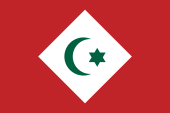 |
1921–1926, Flagge der Rif-Republik – flag of the Republic of the Rif, Quelle/Source nach/by: Wikipedia (EN)   |
|
|
|
| Im Jahre 1920 kam es in Spanisch-Marokko zu einem Anti-Spanischen Aufstand der Rif-Kabylen unter Abd-al-Krim mit dem Ziel der Unabhängikeit von Spanien. Es gelang den Aufständischen etwa 70% des Territoriums von Spanisch-Marokko in Besitz zu nehmen. Die Rif-Republik wurde am 18.09.1921 proklamiert. Sie hatte etwa 150.000 Einwohner und Hauptstadt war Ajdir. Ab 1925 wurde das Land von einer französisch-spanischen Armee niedergekämpft und im Mai 1926 besiegt. | In
1920 there was an anti-Spanish uprising of the Riffians under
Abd-al-Krim in Spanish Morocco with the aim of independence
from Spain. The insurgents managed to occupy about 70% of the
territory of Spanish Morocco. The Rif Republic was proclaimed
on 18th of September in 1921. It had about 150.000 inhabitants
and the capital was Ajdir. From 1925 the country was defeated
by a Franco-Spanish army and defeated in May 1926. |
| Quelle/Source: Wikipedia (DE) | |
|
|
|
|
Mit freundlicher Untersützung von: Kindly supported by: |
E. Hoheisel (D), Jürgen Kaltschmitt (D) |